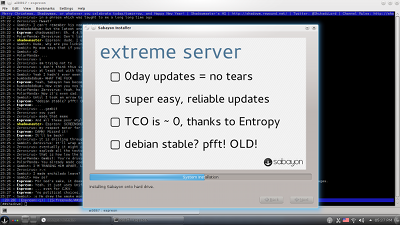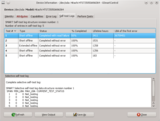Chromium: day two
A couple of things:
- I cannot press Escape on a loaded page to stop all playing GIF animations.
- There isn’t an obvious way to search page contents backwards with the keyboard as in Firefox (it is Shift+F3 there).
What the hell?
A couple of things:
What the hell?
For more than a year I have been actively avoiding the web browser that all the cool kids use these days. I’m obviously talking of Google Chrome.
For all its excellent performance and ease of use, I kept being bothered by its insistence on breaking the mold and looking like a completely different thing running on my Linux system, instead of behaving like an application blending with its environment. I think it was this big annoyance that kept me from adopting it as my regular web browser for all this time. But compared to Mozilla Firefox, I think there’s just no matter of dispute anymore. Chromium/Google Chrome keeps getting better, and Firefox is stuck in the noughties, much like an evolutionary dead end in the history of fail web browsers.
It’s only been a week since version 0.7.3 of After the Storm came out. As I said some time ago, I’m not announcing minor releases in my blog anymore since they can get on occasion a little too noisy for my taste. However, today’s release, version 0.7.4, is special in a few ways.
After the Storm’s development began in 2008, some time after the completion of Invasion from the Unknown. Since then, the campaign’s development was repeatedly and severely hindered by multiple planning issues, partially caused by (borderline pathological) perfectionism on my part; plus many other personal problems.
During most of 2011, development was unofficially halted, with a half-baked E1S9.2 lingering around in the Wesnoth-UMC-Dev SVN trunk for months. Version 0.4.0 was released near the end of September, and from that point onwards, I decided to not stop working on the campaign ever again, until it reached completion.
That day, sadly, arrived sooner than I expected. Version 0.7.0 is here, presenting a complete Episode II with 12 scenarios, adding E2S8 through E2S12 to the line-up found in version 0.6.1.
commit 9f6bd04ec405d3987a513ae490fcfef7fad6a034Author: shikadiqueen <shikadiqueen@87cc232e-6748-0410-ac04-a3fa75566414>Date: Mon Jan 16 03:22:28 2012 +0000AtS E2S12: completed epilogue scenarioThis makes After the Storm 100% complete in terms of scenario count.git-svn-id: https://wesnoth-umc-dev.svn.sourceforge.net/svnroot/wesnoth-umc-dev/trunk/After_the_Storm@12917 87cc232e-6748-0410-ac04-a3fa75566414
I never thought this day would come.
At long last, 2011 is coming to an end. In a few hours, we’ll have to dump our old calendars to replace them with new ones bearing the number 2012 in a big font size. Then the people who believe 2012 will be the end of life on Earth will begin to panic as we approach December again. Those nutcases.
This was a relatively calm and monotone year in what pertains to my personal life, so I’m not going to delve into details in this opportunity. However, I made some resolutions last New Year and it might be worth it to review them and check why I didn’t accomplish all of my goals.
One particular resolution deserves separate analysis, though:
Then there’s Wesnoth. I intend to finish the Second Act™ of After the Storm Episode I as soon as I may, even through the means of placeholders — I’m willing to do anything to rescue AtS out of Development Hell before the end of 2011.
I didn’t resort to unlawful methods to accomplish this goal as I originally feared, but it still happened! Granted, rather late.
During September and October I had a rather unexpected creativity and productivity spurt which culminated with the release of AtS version 0.5.0 with Episode I: Fear complete with 13 scenarios. More recently in December, we reached version 0.6.1 with 7 complete scenarios for Episode II: Fate. As of this writing, E2S8 and E2S9 are also complete in SVN trunk in Wesnoth-UMC-Dev, although it’s been suggested that the latter could use some spicing up. E2S10 is a work in progress since yesterday, and part of E2S12 was written already back in October, just not committed.
Thus, it could be said that after many difficulties, After the Storm broke out of Development Hell. Whether I’ll consider Episode III: Final (expected to be shorter, around 6 scenarios) part of the required line-up for version 1.0.0 is a matter I haven’t settled yet.
Once After the Storm is finished, I plan to take a rather long break from campaign development. That isn’t to say I’m out of ideas, since there is one character I want to explore in further detail in her own campaign. However, I may have my Wesnoth time taken up by mainline work after 1.10 is released depending on the situation then, since there’s a rather large technology gap in Wesnoth that needs to be solved.
Other than that, I haven’t really decided on any resolutions for 2012, so I’ll leave you with the one resolution of the moment:
...screen #0:dimensions: 1280x800 pixels (338x211 millimeters)resolution: 96x96 dots per inch...
(This information is utterly wrong. xdpyinfo reported the same screen dimensions on bluecore last year in spite of its screen being glaringly larger than reicore’s by a few milimeters.)
My friend just mentioned on IRC a rather unusual banner displayed during the installation of Sabayon Linux, somehow involving Debian. I didn’t pay much attention to his claims at first, but then he uploaded a screenshot he’s kindly authorized me to repost:

Isn’t it nice to know there are Linux distributions resorting to over-simplified, uneducated statements to promote themselves? And the banner design itself is ugly as well. I think this merits no further analysis.
Since people keep saying WML is like XML, I decided to provide an example of what a standard WML snippet would look like if it had to be translated to XML.
WML:
[event]name=last breath[filter]id=shadowm[/filter][message]speaker=shadowmmessage= _ "NO!"[/message][/event]
XML:
<event name="last breath"><filter id="shadowm"/><message speaker="shadowm" message:gettext="NO!"/></event>
My knowledge of XML doesn’t go far enough, but I don’t think I’ve ever heard of translatable strings being an integral part of the syntax, hence the funky-looking XML attribute name for event.message.message above.
This example only covers the basic WML syntax (i.e. no preprocessor directives, +nodes or embedded Lua) on purpose.
As I previously reported, reicore’s hard disk might be dying. This is not surprising in the least, since I have been hearing loud noises from the drive during high activity since a long while — playing vanilla Minecraft is apparently the most straining task for it for some reason. Considering reicore didn’t present any such issues at the beginning, it’s possible the person who gave her to me when bluecore croaked did something bad to her while I wasn’t looking. He’s unlikely to confirm such a thing, though.

A short drive self-test last night revealed that one of the bad blocks is currently part of the very root filesystem. Since I started to consistently hit a bad block while logging into KDE, I decided to run e2fsck -c on all partitions from a Grml live CD system (also Debian-based).
(Yes, I just realized I inadvertently left the swap partition out of the emergency check procedure. I just ran badblocks on it in read-only mode and it appears to be clean.)
Scanning a 466 GiB hard disk for bad sectors isn’t a quick task, but it took just as long as it did with the 1.18 GiB disk on my first computer back in 1998 — about two hours and some minutes — and here are the good news: there are only two damaged sectors, both of them within the root filesystem, and only one file was lost: /usr/lib/libQtDesigner.so.4.7.3, provided by the libqt4-designer package in Debian wheezy.
Why the dynamic linker felt it necessary to access this file while launching Akregator and KMail during the login process is beyond me, but it’s good that nothing was lost, as I promptly reinstalled the package. Either way, I had a fresh pre-upgrade backup in my external 2 TiB hard disk drive ready just in case.
I’ll certainly have to get used to making backups more often than my previous, sloppy biweekly n-weekly schedule. Thanks goodness for rsnapshot.
The last time I tried to switch from Debian stable to testing I was hit by a disease known as X.org Server 1.10, and more specifically, fd.o bug #31017, which made my KDE experience less than worthwhile, to say the last. The solution I devised was not particularly productive either.
However, X.org Server 1.11.1 hit Testing a while ago, and it’s what I am using right now — I successfully switched to “wheezy” again, today, and this time it would seem a massive rollback won’t be required, since the aforementioned bug is finally fixed.
I don’t think I can claim the upgrade was smooth, though.